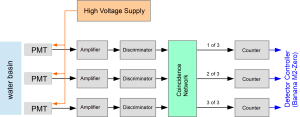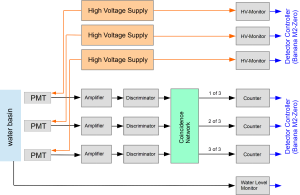Muon Observation
The observation of muons as a result of cosmic rays (CR) is possible by amateurs. For this purpose Geiger-Müller tubes, scintillation sensors, Water-Cherenkov detectors and CMOS image sensors are used. In all cases, CR-induced detection must be distinguished from other events in the sensors. Lead shielding and coincidence arrays are commonly used for this purpose.
The system shown here is based on water-Cherenkov detectors, with many suggestions and hints taken from the “Pierre Auger Observatory” project.
Preliminary work
To learn about the error budget, series of experiments had been performed first, using small glass cylinders and one PMT. One of the results was, that the use of distilled water is not necessary, provided that no iron is dissolved in the water. The counting rate depends on the anode voltage of the PMT, so that a constant high voltage supply of the PMT must be ensured.
Detector efficiency is improved dramatically by providing a reflective shielding for the glass cylinder. A shield of lead sheet is sufficient, but can be omitted altogether when the bottom of the cylinder is about 20cm above the ground. There had been no significant changes in the count rate in this case.
First version
The first version of the detector consists of a glass cylinder wrapped with aluminum foil and filled with water. The cylinder is housed light-tight in a metal tube, the bottom of the tube is lined with a layer of lead. At the top, the actual sensor assembly protrudes into the glass cylinder and the PMTs are immersed in the water. Coincidence is achieved by an arrangement of three PMTs.
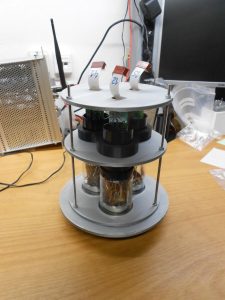
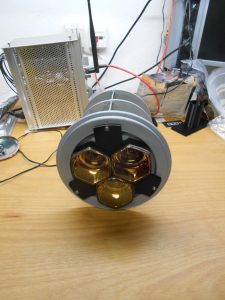
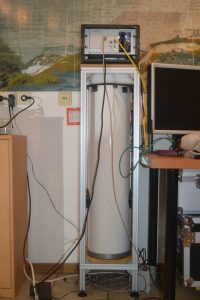
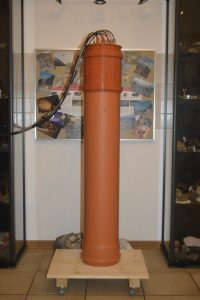
Second version
With the experience of the first version, the high voltage supply was revised for the second version. Now each PMT has its own high voltage supply. Each high voltage is monitored and the values are stored with the counter values. In addition, a water level sensor was installed to prevent the PMTs from running dry. The housing of the glass cylinders, previously a metal tube, has been replaced by a standard plastic tube, so that now a kind of volume manufacturing can be done.
